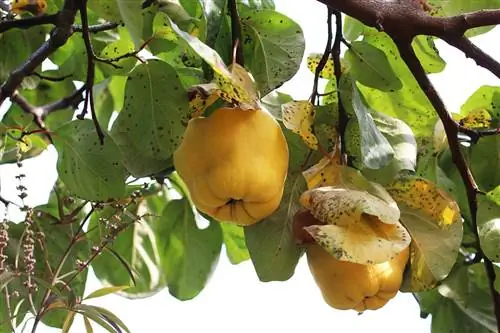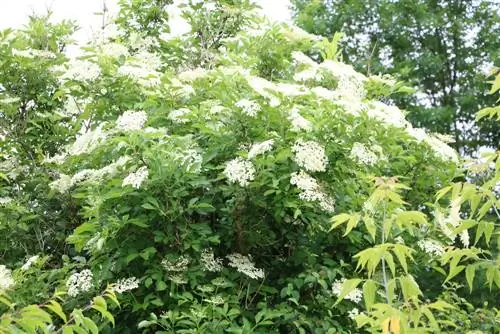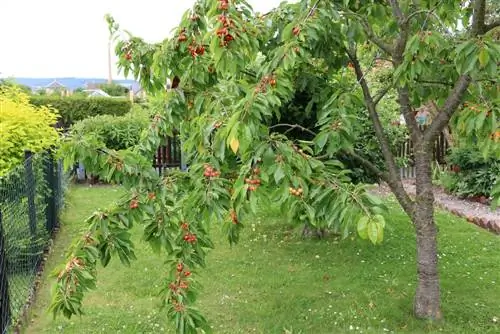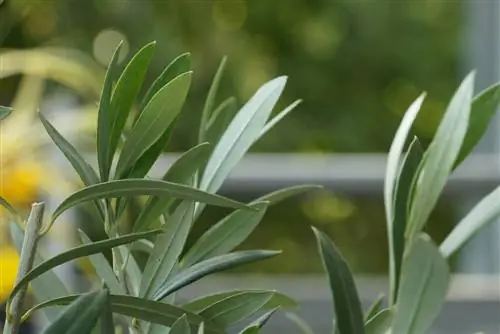- Author admin [email protected].
- Public 2023-12-17 03:39.
- Last modified 2025-01-24 12:45.
The olive tree is mostly associated with southern Europe, which is correct. It occurs in the areas around the Mediterranean as well as partly on the Black Sea. It is important for the location that there are no extreme climatic conditions.
Heat is no problem for him at all, but he can't stand frost at all. Frost has even caused entire plantations to be destroyed. If you want to plant a single olive tree on your terrace or even in your garden, you should definitely think about it. The original shape of the tree impresses with these facts:
- evergreen tree with heights up to 20 meters
- reaches an old age of several hundred years
- Older leaves are shed occasionally
- Flowering depending on the location from April to June
- Harvest productive after 20 years
The olive tree on the terrace at home also comes from the original tree and therefore has similar properties. In nature, olive trees are propagated by birds. They eat the olives and excrete the seeds, which is enough for reproduction. Tip: There are a total of more than 1,000 varieties of olive trees.
You can grow an olive tree from a pit, but this takes a very long time. Already “finished” olive trees can be bought in special stores. Here they are offered in different sizes/age groups. The prices also depend on this, but you should pay attention to good quality.
The olive tree on the terrace at home
Similar to a citrus plant, the olive tree is associated with the Mediterranean flair. As a container plant, it can therefore be found on sunny terraces, often in the company of a lemon, orange or tangerine tree. Other Mediterranean plants also make beautiful decorations for the terrace, but the olive tree has a very special flair. After all, it was already mentioned in the Bible, which is perhaps why it is so popular.
The olive tree has been cultivated as a useful plant for over 6,000 years. If it is placed in a pot on the terrace, it will not necessarily produce a rich olive harvest, but some of the fruits can definitely be produced. For this to happen, the olive tree, despite all its modesty, needs the right location and the right care. The water requirement of an olive tree is modest because it can use the dew on the leaves to maintain its fluid balance. So it is not necessary to keep the soil of the pot constantly moist.
Location for olive trees
The location for the olive tree should definitely be sunny. Basically, the olive tree doesn't have any great demands on its location as long as it gets enough sun. However, since the sun in our latitudes does not produce such warm temperatures all year round that the olive tree could remain in its place, overwintering is necessary.
- sunny
- protected location
- water only moderately
A location is selected for overwintering that should be bright and cool. Temperatures of around 10°C could be present in a hallway or stairwell, for example, even if the brightness is right. However, drafts and constant cold air currents, such as those caused by opening the front door, are not good. The olive tree doesn't have to be packed, but a few precautionary measures are definitely useful.
Preparation for moving to winter quarters
Before the temperatures get cooler and the olive tree is planned to move into its winter quarters, you should prepare the plant for this move. To do this, the water supply is first slowly reduced. This will allow the tree's metabolism to get used to the next period of time and will be able to cope better with the new location. In the winter quarters, watering continues very sparingly to prevent root rot. You can also take this opportunity to check whether the root ball is not too large for the pot. The roots should be covered in a sufficiently thick layer of soil. If this is no longer the case, the olive tree must be repotted.
Tip:
There is a hardy variety of the olive tree “Olea europea Lessini”.
This is probably best suited to be cultivated in northern European latitudes. Even if you don't want to leave it outside in frost and snow, this genus is more robust than other varieties. This has also led many plant owners to leave their olive trees outside, regardless of the variety. It was then simply wrapped up well with fleece and bubble wrap and it probably survived. However, it is important to leave a gap in the film so that the moisture can escape and no condensation forms. A little frost is said to be good so that the olive tree produces flowers next spring.
Tip:
Read more information about wintering olive trees.
Pruning olive trees
If you want to prune your olive tree, this should be done in spring. When shoots begin to form, the branches can also be cut back vigorously; this will not harm the olive tree. Olive trees are characteristically gnarled and have short branches. In addition to pruning, the olive tree should also be thinned out in the middle. Many a gardener thinks that if he could throw a hat through the tree, that would be the right thing to do. Now you won't want to throw a hat through an olive tree, but the purpose of the thinning can be made clear. This allows more light to reach the crown and ensures better living conditions. Maybe an olive tree will also find its place in the garden, then you can later stimulate abundant olive production with such pruning.
What you should know about olive trees in brief
Olive trees are very popular plants for the terrace and garden, both free-standing and in pots. Since they can often grow up to 15 m high, they are increasingly popular as privacy screens, but in most cases they are much smaller and give every garden and terrace a Mediterranean flair.
- Watering olive trees (also called olive trees) requires the least amount of effort. Native to dry climates, this plant can survive on little water and therefore does not need to be watered as often.
- You can also choose the location almost freely, as the olive tree can even survive the blazing midday sun unscathed. However, olive trees cannot be left in the garden in winter as they require a minimum temperature of +10°C and therefore have to overwinter indoors. Olive trees cannot tolerate frost in any way and will suffer corresponding damage.
- An olive tree does not need a lot of fertilizer, you should only start with light fertilization for plants that are older than 3 months. Commercially available liquid fertilizer is sufficient here; there is no special fertilizer to buy. However, fertilization must then be carried out regularly, approx. once per month.
- One of the most common pests is the so-called olive fly. Care must be taken to ensure that the eggs of this fly can be found in the ripe olives.
Olive trees are usually noticeable because of their shape. Above all, the ball cut is very popular. There are even different shapes made of wire mesh for the olive trees, so that you can cut different animal shapes or geometric shapes. But the spherical shape is probably the most common. To do this, you need a spherical basic cut; the growing shoots must then always be shortened accordingly. Since the olive tree grows very quickly and strongly, you have to invest a lot of work and prune the plant quite often. Since the young shoots are very soft and thin, you need little effort, no special scissors and the work is quite easy.
By the way: Cutting has another effect. Where the olive tree has been pruned, a fork with two shoots will appear. In this way it is possible to compensate for inequalities in growth and change the shape of the olive tree.






